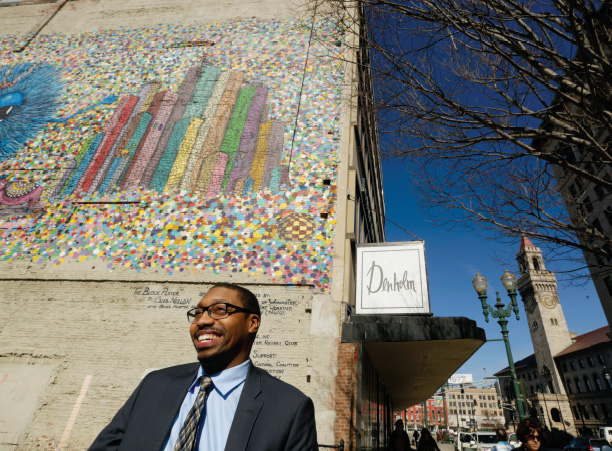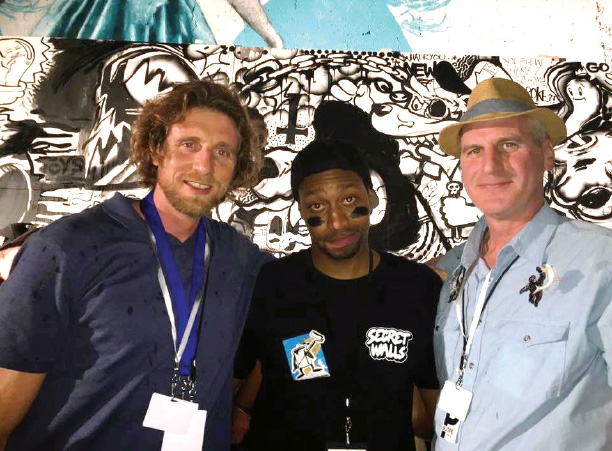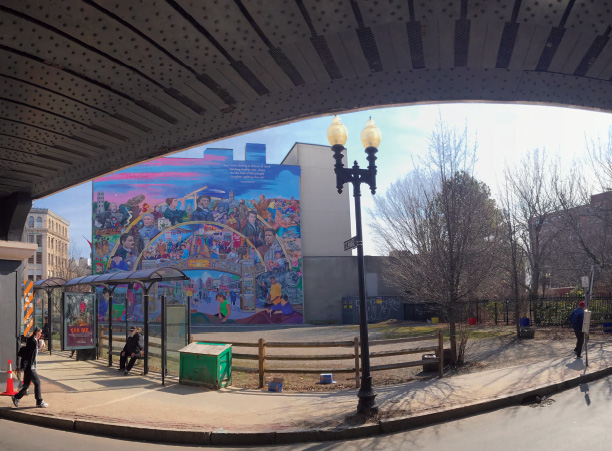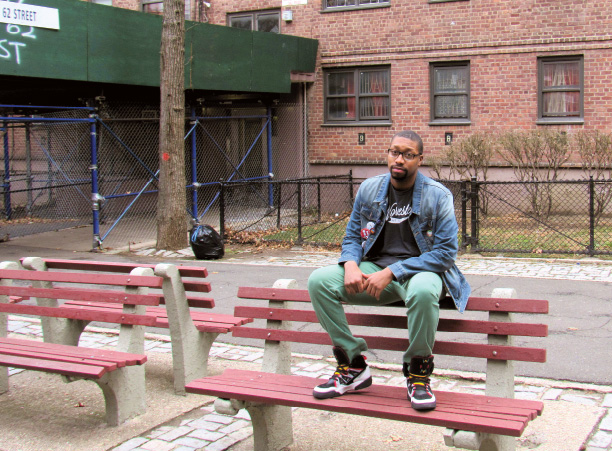 When Che Anderson was growing up in the projects of New York City, his mother ran a tight but loving ship.
When Che Anderson was growing up in the projects of New York City, his mother ran a tight but loving ship.
Her two boys were not allowed to watch TV until their homework was done, not allowed outside after dark and they were encouraged to get involved in extracurricular activities.
Lysa Adams worked as a prison guard at Rikers Island, and she did not want the sons she was raising alone to suffer the fate of the incarcerated young men she saw at work.
From the time he was 4 or 5 years old, Anderson recalls his mother hammering home the daily message that became the family mantra: “In life you have choices. Be a leader and not a follower.”
He took those words to heart, even sharing them with student leaders in a recent talk at Holy Cross.
“If I had a tattoo, which I don’t, that’s probably the one I’d get,” he says with a laugh, during a break from his job as a staff assistant to the city manager in Worcester.
In that role, the 2011 Holy Cross graduate coordinates special events, including initiatives intended to spark the cultural economy of the city. Though he is quick to stress that such projects are a team effort, Anderson has emerged as the point man for public art in Worcester, especially after leading the initiative to bring the mural project Pow! Wow! to the city last year.
Under Anderson’s direction, Worcester became the first city on the East Coast to host a Pow! Wow! festival, which has been held in Hawaii, Japan and Taiwan, among other places. These festivals partner local and international artists with communities to enrich and beautify neighborhoods through art. Late last year, Worcester Magazine named Anderson its 2016 Person of the Year, calling him “pretty much the face of the local effort to bring the festival to fruition.”
Now, Anderson’s energy and expertise are being tapped to bring public art elsewhere, including Lynn, Massachusetts, which, like Worcester, is a former industrial city that sees art as one way to boost revitalization. He’s working with Joe Mulligan ’87, a transformative development fellow for MassDevelopment, the state’s economic development and finance arm.
“The hope is that we might be able to tap into his experience, connections and resources to export some of those best practices, and apply them to Lynn and other places,” says Mulligan, a third generation Crusader.
Choosing to “Do More” in Worcester
Anderson attended two high schools in Manhattan, Rice and Regis, and it was a Jesuit brother at Regis who recommended that he look into Holy Cross in “Worchester.” Anderson fell in love with the place during a weekend visit.
And it was Ed Augustus, then director of government and community relations at Holy Cross and now Anderson’s boss as city manager, who convinced him to stay in Worcester after graduating.
Anderson says he had considered himself a “big city guy” who might go into law and return to New York after earning his degree in political science and government at Holy Cross. But during college, his appreciation of art, music and theater grew, and the idea of a law career became less enticing. What made his decision clear, however, was a suggestion from Augustus: that he could do more for a developing city like Worcester than a much bigger one like Boston or New York.
He served as a graduate intern in the Office of Multicultural Education at Holy Cross and worked as assistant director of student activities at the Massachusetts College of Pharmacy and Health Sciences in Worcester before landing his current job with the city manager.
Not an artist himself, Anderson says he’s a promoter and a collector of art, and an aficionado, especially of street art such as murals on buildings.
“One of my hobbies at this point in my life is watching paint dry,” he jokes.
He is tireless in his efforts to promote art in his job with the city, as a member of Worcester’s Public Arts Working Group and as a volunteer elsewhere. Mulligan met Anderson through MassDevelopment, and saw him in action in Miami. Mulligan and Al Wilson, a proponent of a mural project for Lynn, had traveled to Miami to see Wynwood Walls, a former industrial and commercial area near the airport where building facades covered by the work of famous muralists draw tens of thousands of visitors.
While there, they watched as Anderson served as master of ceremonies for a crowd-judged competition between two groups of muralists. “It was fascinating to see this kid from Holy Cross commanding a crowd of people down in Miami,” Mulligan recalls.
 From left, Al Wilson of Lynn’s mural project, Anderson and Joe Mulligan ’87 at Wynwood Walls in Miami, a former industrial area reclaimed and revitalized by murals.
From left, Al Wilson of Lynn’s mural project, Anderson and Joe Mulligan ’87 at Wynwood Walls in Miami, a former industrial area reclaimed and revitalized by murals.Changing a "Sense of Place" Through Art
It might seem that struggling post-industrial cities would have higher priorities than art, but planners and developers see it as integral to revitalization efforts. Success stories can be found across the country, including Pittsburgh, Cleveland and Grand Rapids, Michigan.
“Arts and culture are key contributors to a community’s well-being, along with adequate transportation infrastructure, affordable housing and economic opportunity,” the National Endowment of the Arts writes on its website. “It is evident that arts and cultural strategies hold great promise for American communities to reinvent themselves and imagine a strong, more resilient future.”
Providence, Rhode Island, owes much of its comeback to WaterFire, which features 100 baskets of flaming, fragrant wood on the waterways that wind through a mile of the city’s downtown. Begun in the 1990s, WaterFire events also feature music and other performances. Each WaterFire draws 100,000 people downtown, and the project is credited with reviving the city’s economy and public spirit, according to the Project for Public Spaces, a nonprofit organization that helps communities enhance public places.
Mulligan saw the transformative power of art when he lived in Boston’s Fort Point Channel Historic District. Buildings once used for warehousing and manufacturing had been abandoned before artists moved into the expansive loft spaces, forming what became New England’s largest artist group, the Fort Point Arts Community, and eventually making the area a highly desirable place to live.
“All these post-industrial cities that had great heydays at the turn of the last century have struggled to find their footing in today’s economy,” says Mulligan, who holds degrees from Holy Cross, Boston Architectural College and the John F. Kennedy School of Government at Harvard.
Such cities have rich architectural and cultural histories that can be tapped, he points out. “When you look at them with fresh eyes, you can begin to tease out those stories and find ways to reinterpret them through art or cultural activities, place-making strategies or just having events to bring those areas to life,” he says.
The arts can change people’s perceptions of an area, Mulligan says, and when that happens “the market will follow,” attracting business development, real estate conversions and new residents, all while improving the lives of people already there.
Worcester has a number of things coming together, he points out, including transportation improvements, downtown development that respects traditional cityscapes - unlike some of the urban renewal projects of the 1960s and 1970s - and a blossoming arts, entertainment and residential area in the Canal District.
“That begins to feed on itself,” he says.
Mulligan, who has served in a number of real estate development and revitalization positions in Boston, says he always had a predilection for architecture.
“Architecture is the mother of all arts,” he says. “You can see how you can go from the smallest installation to a mural to a beautiful building. All have the power of beauty to transform people’s perception, and begin to change the sense of place.”
Mulligan hopes the Lynn mural project, in that city’s designated arts and cultural district, will get underway at the end of the summer. Before then, walls for the murals will be identified, access rights must be secured, artists and volunteers recruited, money raised and materials gathered.
 Murals depicting the history of Lynn adorn the side of the LynnArts Building in the town’s Central Square. Anderson is working to bring more public art to Lynn this summer.
Murals depicting the history of Lynn adorn the side of the LynnArts Building in the town’s Central Square. Anderson is working to bring more public art to Lynn this summer.Bringing Pow! Wow! to Worcester
That to-do list is similar to the one Anderson followed last year in Worcester for the Pow! Wow! event. The 10-day festival featured more than a dozen large-scale murals on building walls, painted by artists from across the country and around the world.
And Pow! Wow! will be back this year in Worcester, with new artists painting as many as 15 to 20 murals on new facades, including one on the side of Coney Island, the iconic downtown hot dog venue. Anderson says there will be more opportunity for local artists and he’s hoping to engage more youths in the festival, perhaps meeting with the artists and even doing some painting. Fellow Holy Cross alum Sarah Valente ’16 is coordinating walking tours that include restaurants and bars along the way.
Anderson is also hoping artists will be paid this year, although last year they were provided lodging, meals and supplies.
He calls the event a cultural exchange, one that involved Worcester in the national conversation on the arts and gives people one more reason to live in a city that he says is constantly developing. The city that once depended on manufacturing wire, clothing, abrasives, guns and other products made possible by the Industrial Revolution is still one of makers and creators, but now in a different way.
Worcester’s arts beautify the city, tell its history, enhance its walkability and appeal to millennials like himself, says Anderson, who considers art an aspect of a community’s livability. And, along with other developments, arts have upended a cynical mindset that had been in place for decades.
“It’s an amazing thing for people to have civic pride,” he says. “So I’m excited. I’m here at the right time.”
Anderson notes that many of the people involved in bringing Pow! Wow! to Worcester were not natives of the city, which he views as an example of college graduates staying and getting involved. Worcester has a lot to offer young people, he says, including job and business opportunities, livability, affordability and easy access to other communities. He has lived downtown since moving off College Hill.
Though he studied political science and planned to go into law, Anderson says that during his time at Holy Cross “I was forced to dabble in different things. That gives you a different perspective on education.” He developed an interest in art, history and community development, and participated in Holy Cross Cares Day, the YWCA’s Stand Against Racism, various conferences and student education groups.
“Whether it’s on The Hill or off The Hill, Holy Cross had embedded in me that whatever it is you do, you get involved and engaged,” he says.
Last year was a big one for Anderson, who received a key to the city as well as the honor from Worcester Magazine. Augustus told Worcester Magazine, “Che is a really dedicated city employee. He brings the same amount of passion to everything he does. He has a real passion for art in general, murals in particular.”
Adds Erin Williams, the city’s cultural development officer, “Che and other volunteers brought Pow! Wow! Worcester to life last year, bringing world class international and local muralists to Worcester for a summer mural festival. There was no stopping them. Needless to say, Pow! Wow! Worcester was a smashing success.”
 Che Anderson ’11 visits his childhood home in New York City.
Che Anderson ’11 visits his childhood home in New York City.He told Worcester Magazine she is the “toughest woman I know.” But Anderson, in the interview for this story, said his mom was also nurturing and fun.
As a teen, he once challenged her to play one of his favorite video games, “Street Fighter II.” “Let me show you how to play this,” he remembers saying. Then, she beat him at his own game. “She just whipped me bad.”
In the years that followed, Anderson made plenty of choices to make his mother proud, but staying in Worcester initially was not one of them. She had expected her son to return to New York.
“She couldn’t understand why I didn’t want to come back to NYC,” Anderson says. “Since then she’s been extremely supportive and proud of my role and accomplishments here. She just wants me to lead a fulfilling life, without some of the struggles she had to endure.”
Written by Dave Greenslit for the Spring 2017 issue of Holy Cross Magazine
About Holy Cross Magazine
Holy Cross Magazine (HCM) is the quarterly alumni publication of the College of the Holy Cross. The award-winning publication is mailed to alumni and friends of the College and includes intriguing profiles, make-you-think features, alumni news, exclusive photos and more. Visit magazine.holycross.edu/about to contact HCM, submit alumni class notes, milestones, or letters to the editor.
Related Information: